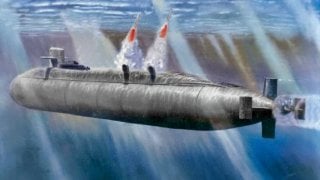727 Days and 70,000 Miles: A Navy Ohio-Class Guided-Missile Submarine 'Made History'
USS Florida (SSGN-728), originally commissioned as a ballistic missile submarine, was converted to a guided-missile submarine in 2006. It made naval history with a patrol that lasted over 70,000 miles, spanning two years.
What You Need to Know: USS Florida (SSGN-728), originally commissioned as a ballistic missile submarine, was converted to a guided-missile submarine in 2006.
-Since then, it has played a vital role in operations like Odyssey Dawn in Libya and, more recently, completed an unprecedented 727-day patrol spanning multiple theaters.
-The Florida's ability to launch 154 Tomahawk missiles and deploy Special Forces made it indispensable in the Global War on Terror.
Not All is Well: However, the extended deployment highlights the strain on the U.S. Navy's fleet, revealing the need for more resources and shipbuilding to counter growing threats like China’s expanding naval capabilities.
USS Florida: A Testament to U.S. Submarine Prowess, but at What Cost?
The USS Florida is a legendary Ohio-class guided-missile submarine (SSGN). Having been deployed in 1981, she was originally commissioned as a ballistic missile submarine with the designation (SSBN-728). In 2003, it was converted to a guided-missile submarine, earning the designation SSGN-728. The submarine completed its conversion in 2006. It would go on to complete multiple mission sets in its new role.
The conversion of the submarine was a perfect move, given the era that it was converted in. Originally designed to deter the Soviet nuclear threat in the Cold War, in 2003-06, the Global War on Terror was a different kind of conflict.
Indeed, the Florida would be far more useful to the Navy in its application of force as a guided-missile submarine as opposed to a ballistic missile sub because the Global War on Terror was a conflict of Special Forces and long-range bombardment of terrorist targets. Florida was well-suited for this mission set.
Thus, it ended up having a stellar second life as an SSGN.
An Historic Opportunity
USS Florida played a pivotal role in Operation Odyssey Dawn, which was the Obama administration’s attack on Muammar Gaddafi’s Libya. The Florida joined multiple warships and hit several targets of opportunity in Libya at that time. It likely also deployed US Special Forces operators into Libya during this time.
Despite its already impressive service record, though, the Florida’s most important mission set was only just recently completed. This came when the Florida returned to port after an historic 727-day patrol. This patrol represented a monumental achievement in submarine engineering as well as a vital step toward restoring deterrence at sea.
Spanning multiple theaters of operation, crossing into the areas of responsibility belonging to the Fifth Fleet, the Sixth Fleet, and the Seventh Fleet (the Middle East, Europe, and the Western Pacific), the Florida served as a vital force multiplier in three areas that are currently undergoing major instability. As an SSGN, the Floridais able to launch upwards of 154 Tomahawk cruise missiles at distant targets as well as deploy elements of US Special Forces.
An Impressive Feat
The ability of the Florida to operate continuously for more than 700 days while remaining undetected and traversing nearly 70,000 miles around the world reassured allies while adding uncertainty into the dastardly plans of America’s rivals. By not knowing where, precisely, the Florida was, America’s foes could never be quite certain where this submarine was, whether it was near Iran or Russia or China.
SSGN-728 participated in strikes against Houthi targets in Yemen, when the submarine popped off Tomahawk cruise missiles. The boat is also believed to have hosted US Special Forces during its time in the Middle East and likely deployed them on covert missions.
Moreover, the Florida circumnavigation of the globe showed to the world that American nuclear-powered submarines remain the best in the world. These missions also prove that US Navy submariners are the best in the world.
After all, these crews were kept at sea for more than two years. They never cracked under pressure. There were no accidents or mistakes made. The submarine performed as it was expected in each area of operation that it traversed.
The Downside of the Patrol
At the strategic level, however, the submarine’s historic mission served to reinforce the notion that the US Navy was a global force. Sadly, the fact that this mission had to be undertaken is a quiet admission that the Navy is stretched too thin.
Yes, it was a successful and impressive feat for the submarine. One for the history books.
But the reason she was sent out of port for two years was because the Navy is feeling the pressure from multiple threat actors and, as it turns out, the Navy lacks the proper force size to deter these rising foreign threat actors. Therefore, the Pentagon is sending its limited sub force on extended patrols across the world to restore deterrence.
While the presence of the Florida did bring a momentary burst of deterrence into whatever region it was operating in, the moment that sub went away, the chaos returned. A larger Navy fleet would be able to address these problems simultaneously.
Meanwhile, rivals, notably China, build their navies up. The People’s Liberation Army Navy (PLAN) already has more ships in its fleet than does the United States Navy. Now the Chinese are going on a submarine building frenzy, too.
For all the ra-ra about the Florida’s historic deployment, its impact at the strategic level is mixed at best. The Navy needs to throw its resources into rehabilitating America’s failing shipyards and then building many more units of submarines. No amount of historic extended patrols by a limited number of US submarines will stop a numerically superior foe from exerting its will.
Author Experience and Expertise: Brandon J. Weichert
Brandon J. Weichert, a National Interest national security analyst, is a former Congressional staffer and geopolitical analyst who is a contributor at The Washington Times, the Asia Times, and The-Pipeline. He is the author of Winning Space: How America Remains a Superpower, Biohacked: China’s Race to Control Life, and The Shadow War: Iran’s Quest for Supremacy. His next book, A Disaster of Our Own Making: How the West Lost Ukraine, is due October 22 from Encounter Books. Weichert can be followed via Twitter @WeTheBrandon.
All images are Creative Commons or Shutterstock.
From the Vault
Russia Freaked Out: Why the U.S. Navy 'Unretired' the Iowa-Class Battleships
Battleship vs. Battlecruiser: Iowa-Class vs. Russia's Kirov-Class (Who Wins?)


